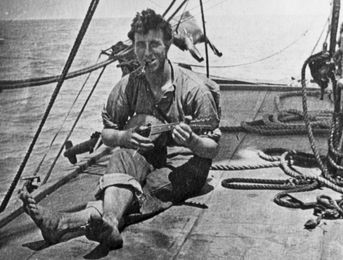Who was Harry Bridges

Harry Bridges is the most well-known Bay Area labor leader. Born Alfred Renton Bridges in 1901 in Melbourne, Australia, he sailed to the United States in 1920 and by 1922 was working on the San Francisco waterfront as a longshoreman. Here he agitated for democratic unionization of the docks and was known for charismatically preaching these ideas while drinking in local pubs. He and others unsuccessfully attempted to start an independent union in 1924 and 1926. Finally, in 1933 a San Francisco chapter of the International Longshoremen's Association (ILA) was formed, which Bridges was promptly elected a leader of.
Having been influenced by both the Industrial Workers of the World (IWW) and the Communist Party he and others saw the need for working class unity. In 1934 they organized all of the West Coast ports and all of the port unions in a joint strike. Both, skilled and unskilled, black and white workers united together, pledging not to end the strike until the bosses settled with every union. Bridges was elected chairman of the strike committee.
When conservative leaders from the ILA attempted to break the West Coast strike, they were promptly rejected by the rank-and-file and their influence and control on the West Coast disappeared. Harry Bridges became the spokesperson for the workers, though he did not control them, as they voted against his wishes at times.
After winning all their demands during the 1934 West Coast strike Bridges was elected president of the Pacific Coast District of the ILA in 1936. A year later the West Coast ports split with the ILA and created the International Longshoremen's and Warehousemen's Union (ILWU) where Bridges served as president for the next 40 years. Here he continued to advocate for democratic unionism, open to membership by all, regardless of race, nationality, or belief. However, later in life Bridges refused to support the Oakland general strike or the Berkeley free speech movement. Despite this, the ILWU remains of the most progressive labor unions in the United States.
The more conservative ILA continued to represent the East Coast works. Overtime the ILA gave in to demands from the bosses while the ILWU made bigger demands for their works. This led to the a situation where West Coast longshoremen make a higher wage and have better benefits than those on the East Coast.
After the workers' victory in 1934, reactionary forces saw Bridges as a symbol and a threat. It was well known that Bridges did not take bribes or kickbacks, and no criminal charges could be brought against him on that front. Instead the government and their big business allies attempted to do to Bridges the same thing they were able to successfully do to many Mexican agricultural strike leaders -- deport him. For the next many years Bridges faced court battles as the state attempted to deport him. This included the federal government passing the Smith Act of 1940, which set criminal penalties for advocating the overthrow of the U.S. government and required all adult non-citizens to register with the government. This law was specifically drafted to deport Bridges. In 1945 a split Supreme Court ruled in Bridges' favor, but it was not until 1955, 21 years after the San Francisco general strike that the government finally ended its attempts to deport Bridges.
Harry Bridges Tributes In San Francisco
Today Harry Bridges is honored in a few different ways in San Francisco. A plaza located between two lanes of The Embarcadero at the end of Market St. was named Harry Bridges Plaza in 2001. Here you can find commuters going between downtown and the ferry building, skateboarders, tourists and a small open air market. It can be a pleasant place to sit down and people-watch if the weather is nice. There are plans to install a Harry Bridges statue in the plaza.
Beyond the plaza, in 2001, Berkeley artist Mildred Howard installed a monument called "Locks and Keys for Harry Bridges" located in between Market and Mission on 3rd street. The monument is a series of large bronze keys stuck in locks in the ground.
1188 Franklin St. at Geary Blvd. is home to the Harry Bridges memorial building, but there is not too much to see there.
After his death in 1990, Bridges's ashes were scattered in the waters of the bay, near the Goldn Gate Bridge.
Bay Area punk band Rancid has a song named after Harry Bridges on their Lets Go album.